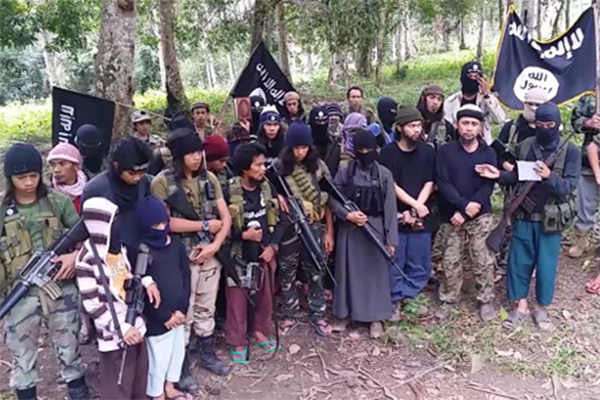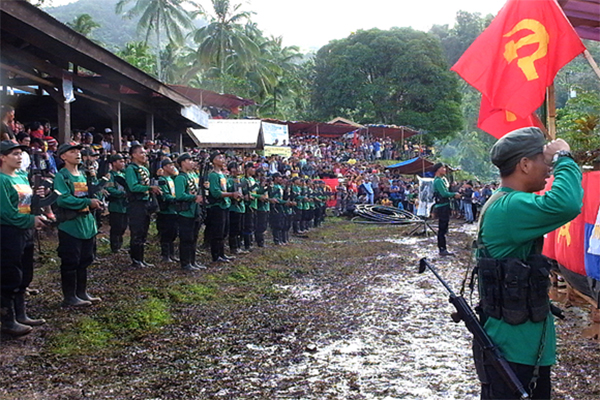The Southern question: Poverty and violence in Mindanao
Mindanao is fraught. We have the peace process—obviously stalled until after elections—with opposing rhetoric about “peace through increased autonomy” versus that of “total war as the ultimate solution” at the other extreme. Presidential candidates present political and development solutions of varying detail. Human rights offenses are claimed by advocates on all sides, but least discussed of all, perhaps, is who exactly is fighting for what in Mindanao.
Despite its vast natural resources and agricultural potential, Mindanao remains the poorest section of the country. Eleven out of the 20 poorest provinces are in this region, with poverty incidences ranging from 44.9 percent (Zamboanga Sibugay) to 74.3 percent (Lanao del Sur). With poverty, hunger, and the lack of economic opportunity strongly felt in these areas, the youth are easily recruited to “live by the gun.” The disparity in access and control over economic and political issues also makes the situation ripe for separatist or class-based armed conflict. Worse, entrenched corruption exists at various levels of governance.
The result is that, in Mindanao, we have jihadists pushing to advance their particular ummah (doctrinal or ideological community); separatists pushing for autonomy of varying degrees, up to and including full independence; Communist proponents of protracted armed struggle aimed at eventually causing the state to wither away entirely; pre-Hispanic sultanates claiming various territorial rights; right down to rido—clan disputes over property or seeking to avenge past wrongs.
For example, even as this column’s being written, fighting continues between the AFP and an Abu Sayyaf Group (ASG) in Basilan—in which 18 AFP troops were killed in an ambush on April 9. Since at least the 18th century, Basilan—because of its size, geography and location—has been a favored hideout.
Established in 1989 by Abdurajik Abubakar Janjalani with $6 million allegedly from al-Qaeda’s Osama Bin Laden, the ASG formed as a splinter group in response to the MNLF’s acceptance of the ARMM agreement. It adhered to the al-Qaeda ideological line until the founder was killed in a police shootout. Once his younger brother, Khadaffy Janjalani, took over leadership in 1998, the ASG’s focus became kidnapping, robbery and murder—with a smattering of rape, child sexual assault, forced marriage, drive-by shootings, extortion, and drug trafficking thrown in—taking on a financial rather than ideological mantle.
Following the death of the latter in 2007, and with military and police actions exerting increased pressure, the ASG split up into smaller groups—one is almost tempted to call them “gangs”—but still with some convoluted sense of jihad as a driving commitment. Perhaps because al-Qaeda financial support dried up, or else out of some sense of doctrinal purity and zeal, one such group, under the leadership of Isnilon Totoni Hapilon, swore an oath of loyalty to Abu Bakr al-Baghdadi, the ISIS leader. Since September 2014, the group’s kidnapping for ransom has been in the name of ISIS.
 This screen capture from a video by the Abu Sayyaf Group released by the Islamic State shows militants in Basilan swearing allegiance to IS leader Abu Bakr al-Baghdadi. Courtesy of the International Center for Political Violence and Terrorism Research.
This screen capture from a video by the Abu Sayyaf Group released by the Islamic State shows militants in Basilan swearing allegiance to IS leader Abu Bakr al-Baghdadi. Courtesy of the International Center for Political Violence and Terrorism Research.
Whether any particular sub-group of the ASG can be seen as a “genuine” affiliate of ISIS, though, is an open question, but this does not necessarily suggest that ISIS has a strong foothold in the Philippines. But far more than al-Qaeda, ISIS is extremely present online, making it possible for armed groups anywhere with internet to swear loyalty to them. While that surely means that ISIS—by its very nature—will encourage its remote affiliates to commit acts of the greatest possible terroristic impact, in a recent press conference, both US and Filipino authorities played down any kind of actual ISIS operational control.
On April 14, during a joint press briefing, Philippine Defense Secretary Voltaire Gazmin and US Secretary of Defense Ashton Carter said that there is no formal ISIS organization in the Philippines. Likewise, Maj. Filemon Tan Jr., spokesman of the Western Mindanao Command—the on-the-ground force in Basilan—dismissed claims (reported by Reuters) that ISIS was behind the April 9 attack as mere propaganda, even questioning if the source of the report was really ISIS, based on the information given.
But those warning of ISIS and the dangers their involvement entails are not completely off base either. As US Secretary Carter pointed out, it is part of a “worldwide phenomenon” of smaller terror groups affiliating themselves with ISIS.
“That’s one of the reasons why it’s so important that ISIL be destroyed in Syria and Iraq, which I’m confident we will do with our coalition partners. And that will demonstrate that there is no such thing as an Islamic State based upon this hateful ideology,” he said.
To bring this complex discussion full circle—and return to the development & national unity issues I want to address—it bears mentioning that less than a fortnight before the brutal April 9 ambush, it was a combination of AFP and MILF militia that overran an ASG base in Basilan. In fact, despite the BBL vote having fallen by the wayside for the moment, the MILF is actively working with the AFP against the ASG, the BIFF and other terrorist groups. This is in addition to the AFP and PNP having large numbers of personnel freed up from their previous duties of keeping the MILF under control.
The ASG is as intractable as it is partly because it has committed so many outright crimes—actions that can by no stretch of the imagination be considered “freedom fighting” and that would never be covered by amnesty—but also because they are nestled in areas where they have many family members and life-long friends to protect them. (The Janjalani brothers are from Basilan, as are many of their earliest recruits.)
The other jihadist terror group affiliated internationally is the Jemaah Islamiyah (JI), which, having started in Indonesia with the intention to form a regional caliphate, lacks the kind of Filipino support the ASG enjoys. With backing from al-Qaeda, JI has been active in Thailand, Singapore and Malaysia, with a few forays into the Philippines, where it uses areas like Basilan and Maguindanao as a hideout, paying their way by passing on expertise, mainly in bomb-making.
By far the most notorious of our islands’ international fugitives, the term “JI” is now applied almost generically to foreign terrorists on the lam—which makes counting them difficult—but where ASG is considered to have around 300 members, JI is counted in the area of 30 or so. Still, since it is “high value” members that JI is prone to protect, they are capable of facilitating a great deal of damage and bloodshed. For all of that, there is still not much evidence that they have any operational organization in the country.
Far more disruptive is the homegrown New Peoples’ Army (NPA)—under the umbrella of the National Democratic Front (NDF)—part of the Communist Party of the Philippines. Just as the ASG is a power of magnitude stronger than the JI (30 to 300), the NPA is a power of magnitude larger than the ASG, with an estimated strength of over 3,000. Subscribing to the Maoist doctrine of protracted armed struggle, they do everything possible to ensure that the government fails at whatever it does. Sometimes their activities are direct—as in blowing up infrastructure, power lines and disrupting education in various ways—making sure that the poorest of the poor are unable to receive any benefit from government programs.
 A company of New People's Army guerrillas present arms as they sing the communist hymn “Ang Internasyunal” at the start of the CPP’s 47th founding anniversary in Agusan del Norte on December, 2015. Photo by Kodao Productions.
A company of New People's Army guerrillas present arms as they sing the communist hymn “Ang Internasyunal” at the start of the CPP’s 47th founding anniversary in Agusan del Norte on December, 2015. Photo by Kodao Productions.
Other times, they take on a more Janus-faced approach, collecting “revolutionary taxes,” sabotaging private sector attempts at bringing in more jobs or concocting schemes where so-called “oppressors of the people” are tricked into oppressing the poor even more—thereby facilitating violent uprisings. Though it’s difficult to find incontrovertible evidence, it’s also hard to find a situation where demonstrators were killed by the authorities where the NPA wasn’t involved in creating and escalating the demonstration.
But, finally, let’s look at how the social, economic and political situation in Mindanao helps make all of this possible. Because this is exactly what the incoming administration is going to have to face up to and deal with.
First and foremost, the youth of Mindanao—Christian, Muslim and Lumad—are at risk. Groups like ISIS are as expert at online recruitment as they are at swelling the size of their international influence. There is no technological “fix” for this, especially when local media and mainstream online news outlets are so cooperative with publishing every ISIS propaganda claim. Propaganda aside, however, it is the conditions under which the youth of Mindanao are presently living that make them ripe fruit for various kinds of extremist indoctrination.
Lack is a powerful mobilizer. Lack of food, clean drinking water, health care, education and a modicum of opportunity to make an honest living. “Safety net” programs must be made to work better, even as they have to be expanded. It is fortunate that some good programs and infrastructures are already in place. Still, more work is necessary: with improved governance, hopefully new, more imaginative programs may come about.
Governance—and corruption—form another set of issues that must be addressed by the next administration. The drive for, and the opposition to, autonomy is driven by an old and lasting distrust between imperial Manila and the Moros. Among both Moros and Lumads, militarization is an issue that must be addressed with nuance and sensitivity.
The dangers are real. ISIS, with a charismatic leader and a few tens of thousands of violent followers, is for the moment disrupting the world and inflicting untold suffering and death. They’ve shown themselves willing and capable of magnifying their voice worldwide and associating themselves with any number of horrific actions. Their threat must be opposed technically and militarily—but that is not the ultimate solution. The ultimate solution is good governance and a population that manages to break the bonds of poverty and lack to share an equal part in the future of our nation.
- Latest
- Trending
























